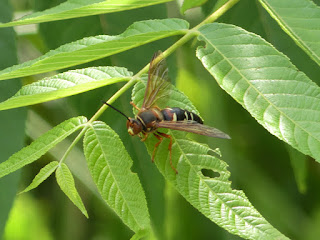Eastern Cicada-killer Wasp
Just like cicadas (especially periodical cicadas) are less than popular, so too are their eponymously named predators, the Cicada Killer Wasps. While cicadas can both physically inundate an area and also be aggravatingly loud, cicada killer wasps can be numerous stinging threats. Still, if you can avoid doing rude things like stepping on them, cicada killers (like most wasps) have other things they'd like to do in a day rather than sting you. Unless you're a cicada; if you're a cicada, they really do want to sting you, bring you back to their nest, and provide you as food to their offspring. (I'm assuming that very few cicadas read my blog.)
Back in July while at an Outdoor Education table, I'd occasionally have people come by thinking that they need to alert us about invasive Murder Hornets on the property. I suspect they're actually a little disappointed when I tell them that Murder Hornets are only (and rarely) found in the far northwest part of the country, and what they're seeing is just one of our larger native wasp species. (I think European Hornets are another species around here that get mistaken for the Murder Hornet. Pretty much any unusually large wasp is a candidate for being mistaken for a Murder Hornet.)
There were a lot of these wasps around in July. I saw a bunch of them near the Great Falls Viewing Area; I'm told that the Pet Cemetery also had a lot of them.
AFAIK these wasps time their schedule to coincide with that of the annual cicadas. When we have a brood of the periodical cicadas (generally much earlier in the season) I haven't seen cicada killer wasps around. I suspect this is exactly why periodical cicadas go to the trouble to emerge every 13 or 17 years, to force a specialized predator to either adopt a similar life cycle or endure over a decade of famine.
 |
| July 16, 2022 at Duke Farms Photo 222061756, (c) jpviolette, some rights reserved (CC BY-NC) |



Comments
Post a Comment